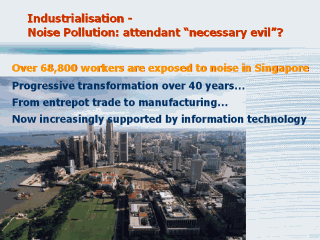| front |1 |2 |3 |4 |5 |6 |7 |8 |9 |10 |11 |12 |13 |14 |15 |16 |17 |18 |19 |review |
 |
While
industrialisation is regarded as key to economic growth and improved living
standards in developing countries, noise pollution has invariably been an
attendant “necessary evil”. It is estimated that there are some 1,200 noisy
factories in Singapore, with over 68,800 workers exposed to excessive noise.
Noise Induced Deafness (NID) is the leading occupational disease, with a few
hundred cases detected each year. Singapore embarked on an intensive industrialization programme over forty years ago. Since then, the economy has undergone progressive transformation from one heavily dependent on entrepot trade with only a few small-scale industries, to one with a significant manufacturing base increasingly supported by information technology. In the 1960s, many of the industries were pollutive and noisy - typically factories manufacturing textile, garments, plastic and paper products. During the 1970s, Singapore’s development strategy shifted emphasis from labour intensive to skill intensive industries, such as chemical, oil refining, electronics, pharmaceutical, shipbuilding and repairing. The 1980s saw a diversification into biotechnology, petrochemicals, the aerospace industry and computer peripherals manufacturing. Since the 1990s, high technology industries have been promoted in support of Singapore’s transition to a knowledge-based economy. Existing manufacturing plants have been upgraded, new microelectronics and wafer fabrication plants set up, and information software and multimedia companies established. |